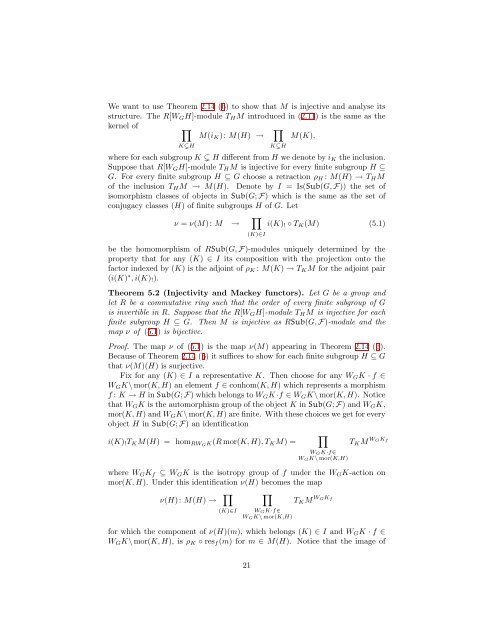Equivariant Cohomological Chern Characters
Equivariant Cohomological Chern Characters
Equivariant Cohomological Chern Characters
You also want an ePaper? Increase the reach of your titles
YUMPU automatically turns print PDFs into web optimized ePapers that Google loves.
We want to use Theorem 2.14 (b) to show that M is injective and analyse itsstructure. The R[W G H]-module T H M introduced in (2.11) is the same as thekernel of∏M(i K ): M(H) →∏M(K),KHKHwhere for each subgroup K H different from H we denote by i K the inclusion.Suppose that R[W G H]-module T H M is injective for every finite subgroup H ⊆G. For every finite subgroup H ⊆ G choose a retraction ρ H : M(H) → T H Mof the inclusion T H M → M(H). Denote by I = Is(Sub(G, F)) the set ofisomorphism classes of objects in Sub(G; F) which is the same as the set ofconjugacy classes (H) of finite subgroups H of G. Letν = ν(M): M → ∏i(K) ! ◦ T K (M) (5.1)(K)∈Ibe the homomorphism of RSub(G, F)-modules uniquely determined by theproperty that for any (K) ∈ I its composition with the projection onto thefactor indexed by (K) is the adjoint of ρ K : M(K) → T K M for the adjoint pair(i(K) ∗ , i(K) ! ).Theorem 5.2 (Injectivity and Mackey functors). Let G be a group andlet R be a commutative ring such that the order of every finite subgroup of Gis invertible in R. Suppose that the R[W G H]-module T H M is injective for eachfinite subgroup H ⊆ G. Then M is injective as RSub(G, F)-module and themap ν of (5.1) is bijective.Proof. The map ν of (5.1) is the map ν(M) appearing in Theorem 2.14 (b).Because of Theorem 2.14 (b) it suffices to show for each finite subgroup H ⊆ Gthat ν(M)(H) is surjective.Fix for any (K) ∈ I a representative K. Then choose for any W G K · f ∈W G K\ mor(K, H) an element f ∈ conhom(K, H) which represents a morphismf : K → H in Sub(G; F) which belongs to W G K ·f ∈ W G K\ mor(K, H). Noticethat W G K is the automorphism group of the object K in Sub(G; F) and W G K,mor(K, H) and W G K\ mor(K, H) are finite. With these choices we get for everyobject H in Sub(G; F) an identification∏i(K) ! T K M(H) = hom RWG K(R mor(K, H), T K M) =T K M W GK fW G K·f∈W G K\ mor(K,H)where W G K f ⊆ W G K is the isotropy group of f under the W G K-action onmor(K, H). Under this identification ν(H) becomes the mapν(H): M(H) →∏ ∏T K M W GK f(K)∈IW G K·f∈W G K\ mor(K,H)for which the component of ν(H)(m), which belongs (K) ∈ I and W G K · f ∈W G K\ mor(K, H), is ρ K ◦ res f (m) for m ∈ M(H). Notice that the image of21
















